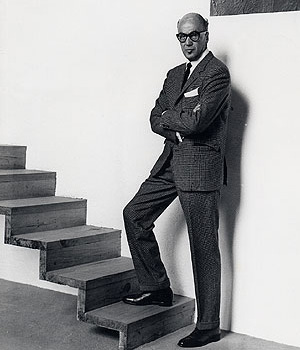
|  |  |  Puerto Vallarta Real Estate | November 2008 Puerto Vallarta Real Estate | November 2008  
Mexico's Most Distinguished 20th-Century Architect Built a Masterly Home All His Own
 Jeanne Claire van Ryzin - Austin American-Statesman Jeanne Claire van Ryzin - Austin American-Statesman
go to original


| | Now a museum open for tours, Casa Luis Barragán is a must-see destination in Mexico City for aficionados of modern architecture and design. | | |
Mexico City - Tucked away on a dead-end street in the modest Tacubaya neighborhood of this sprawling, bustling mega-metropolis lies an overlooked treasure of modern architecture.

The home and studio of famed Mexican architect Luis Barragán has perhaps an appropriately unpretentious exterior, nicely in step with the surrounding low-scale buildings housing small-scale shops, residences and light industries.

But inside, beyond the almost stark plastered concrete façade, is a showplace for Barragán's ingenious use of color and form, light and shadow and his inventive play between inside and out.

Now a museum open for tours, Casa Luis Barragán is a must-see destination in Mexico City for aficionados of modern architecture and design. In 2004, the museum - preserved complete with the architect's furnishings and artwork as he had it when he died in 1988 - was named a UNESCO World Heritage site, taking its place on a roster of notable international cultural sites.

Recipient of the 1980 Pritzker Architecture Prize (often called the Nobel Prize of architecture), Barragán believed that a house should function as a refuge from the outside world. "Any work of architecture which does not express serenity is a mistake," he once wrote. And like other homes of great architects, Barragán's reads as something of an autobiography - an eloquent manifesto in concrete where his ideas on design and on living are perfectly expressed and understood.

Born in 1902 in Guadalajara to a well-off family with a large ranch, Barragán first trained in engineering and only later taught himself architectural skills. In the 1920s, he embarked on the first of many trips to Europe, traveling and studying extensively in France and Spain. In Paris, Barragán studied for a while with Le Corbusier, the pioneering Swiss architect who espoused a sleek, minimalist machine-inspired aesthetic that came to be known as the International Style because of its repudiation of regional design influences. "A house is a machine for living in," Le Corbusier famously proclaimed.

Barragán took Le Corbusier's theories to heart - though not completely. As is evident in his Mexico City home and studio, which he built in 1947, Barragán's mature style brilliantly wove together modern minimalism with traditional Mexican architectural influences. His synthesis of modern sensibilities with vernacular elements - remembered from his childhood on his family's ranch - evolved into a signature style all its own that has been greatly influential, especially on contemporary Mexican architecture.

At about 3,500 square feet, Casa Luis Barragán functioned as both the architect's home and his professional studio; two separate street entrances lead to the living quarters and professional space. Today, the vestibule of the studio serves as a gathering place for guided tours, with a small office off the vestibule now a bookstore stocked with volumes by and about Barragán and architecture in general. (There is an illustrated English-language guide to Casa Luis Barragán available for 150 pesos, or about $12.)

Step inside the foyer of the residence, and immediately Barragán's style announces itself. A saturated magenta wall casts a pink glow onto walls in plain whitewash. Raw volcanic stone floor tiles and unadorned carved volcanic stone stairs contrast in their rugged simplicity with a large gilt square of a minimalist painting that hangs on the landing.

Indeed, throughout the house the same symphony of stark contrasts continues. Moments of bright colors - pink, yellow, orange - balance against swaths of simple whitewashed walls. Plain wood or stone floors become stages for sophisticated minimalist furniture and sumptuous art objects.

An equally sophisticated sense of blending inside and outside is apparent as you journey into the living room. Barragán believed the garden was just as important as the building itself. Hence, double-height windows open to the garden, making the outdoors into an extension of the house and architecture.

That Barragán was able to synthesize such disparate elements and ideas - color and the absence of color, inside and outside, rugged natural materials and sleek artificial forms, modernism and tradition - into a unified whole distinguishes the architect's singular mark on 20th-century architecture. And through its many intriguing spaces, Casa Luis Barragán reveals that genius.

jvanryzin(at)statesman.com |

 |
|  |



